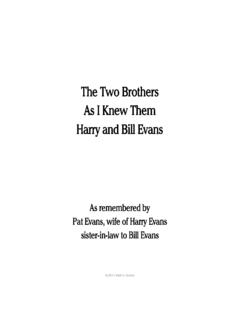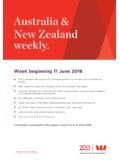Transcription of JELLY ROLL MORTON’s - JazzArcheology.com
1 1 The TENORSAX of HERSCHEL evans Solographer: Jan Evensmo Last update: May 22, 2017 2 Born: Temple, Texas, May 1, 1910 Died: New York, Feb. 9, 1939 Introduction: Herschel evans was one of the all-time greats of tenor saxophone, one of the strongest assets of the Count Basie. After hearing his introduction of Georgianna I was hopelessly addicted to his charismatic playing. Even today my hair raises when I hear his strong and personal sound, and I will go so far as to say that of all jazz musicians in history, one marginal solo discovery has the greatest value! His solography was printed as part of Vol. 2 in my Jazz Solography Series. History: Did early work in " " (Trent's Number Two) Band in Texas (c.)
2 1926), then worked in "The St. Louis Merrymakers" (a Texas band). Brief spells with Edgar Battle, Terrence Holder and with Sammy Holmes in Texas before joining Troy Floyd's Band in Texas (1929). Left Troy Floyd in 1931, stints with Grant Moore's Band, then worked with Benny Moten (Feb. 1933-1935), but no recording sessions. He appears again in 1935 with Richard M. Jones, and became one of the all-time greats of tenorsax with Count Basie 1936-1939. Left Troy Floyd in 1931, stints with Grant Moore's Band, then worked with Benny Moten (February 1933-35), worked in Kansas City with Hot Lips Page's Band, moved on to Chicago, played briefly in Dave Peyton's Band (autumn 1935). Then settled in Los Angeles.
3 With Charlie Echols' Band in Los Angeles, also worked with Lionel Hampton's Band at the Paradise Cafe and with Buck Clayton's Band in the "Brownskin Revue". Joined Count Basie (with Buck Clayton) in autumn 1936 and remained with Basie until fatal illness (ref. John Chilton). Message: The Bill Savory collection gave us an incredible treasure of music from the late thirties, including many of the jazz greats. However, I believe that the Herschel evans discoveries possibly could be the most valuable of all, considering how little we have of this magnificent tenorsax player! 3 HERSCHEL evans SOLOGRAPHY TROY FLOYD AND HIS SHADOWLAND ORCHESTRA San Antonio, June 21, 1929 Probable personnel: Troy Floyd (cl, as, dir), Don Albert, Willie Long (tp), Benny Long (tb), N.
4 J. "Siki" Collins (cl, as), probably Scott Bagby or Herschel evans (ts), Allan Vann (p), John H. Braggs (bjo), Charlie Dixon (tu, b), John Humphries (dm). Two titles were recorded for Okeh, one has tenorsax: 402697-B Dreamland Blues - Part II Solo 12 bars. (SM) From History of Jazz Tenor Saxophone black artists 1917 1934 : SB has confirmed that he played this solo, earlier believed to be by Herschel evans , who joined Troy Floyd in 1929. It is a surprisingly good performance for its time, based on technical command and musical ideas . Postscript of Oct. 2013: Phil Schaap has contacted me, indicating that the solo identification is not that easily solved. It seems that Jo Jones has stated that evans had a copy, and that they listened together, and that evans identified the tenorsax solo as by himself.
5 So we have two contrasting statements, I guess we will never know the truth for sure. JONES' CHICAGO COSMOPOLITANS Chicago, Sept. 13, 1935 Richard M. Jones (arr, dir), Louis Metcalf, Jimmy McLeary (tp), Albert Wynn (tb), Jimmy Hutchinson, Artie Starks (cl, as), Herschel evans (ts), Dave Peyton (p-90324), Gideon Honore (p-90323), Hurley Ramey (g), Oliver Bibb (b), Roy Slaughter (dm), George D. Washington (vo-90323, 90324-B). Two titles were recorded for Decca, one has HE: 90324-A Baby O Mine Soli 2 and 8 bars. (M) 90324-B Baby O Mine As above. (M) This encounter with Herschel evans , which for the author took place after listening to his later works, is rather surprising.
6 He sounds different than on the Basie records, more primitive and staccato in his phrasing, and he is not easily recognizable. However, his soli are characterized by the usual eagerness and forceful attack, is swinging violently, and has no similarity to the products of any of his contemporaries. This "Baby .." definitely has its value both from a historical point of view and for its jazz content. Postscript of Dec. 5, 2016: An alternate of .. Mine has appeared! A vocal has replaced the orchestral introduction on take A! The tenorsax contributions are slightly different, exciting! COUNT BASIE AND HIS ORCHESTRA NYC. Jan. 21, 1937 Buck Clayton, Joe Keyes, Carl Smith (tp), George Hunt, Dan Minor (tb), Caughey Roberts (as), Jack Washington (as, bar), Herschel evans , Lester Young (cl, ts), Count Basie (p), Claude Williams (vln, g), Walter Page (b), Jo Jones (dm), James Rushing (vo).
7 Four titles were recorded for Decca, one has HE: 61544-A Swingin' At The Daisy Chain Solo 8 bars. (FM) Herschal evans ' first recorded solo with Count Basie is quite typical of his production. The time span between his first and last record is only two years, and there is no notable stylistic development. He already had found his own personal manner of expression which was characterized by a unique sound, somewhat dry, but big, powerful and emotional. His style is kind of edgy and winded. However, these effects sound highly intentional. evans brings something new into the realm of tenor saxophone, and the solo is original in the best sense of the word. COUNT BASIE AND HIS ORCHESTRA Pittsburgh, Feb. 1937 Personnel probably as Jan.
8 21, 1937. Broadcasts from The Chatterbox, Hotel William Penn. Items 1-14 on Jazz Archives JA-16. Possibly Feb. 8, 1937 1 Oh, Lady Be Good Solo 32 bars. (M) 2 St. Louis Blues Weak obbligato 12 bars. (FM) 3 Moten Swing (Conclusion) No solo. 4 Shoe Shine Swing No solo. 5 Moten Swing (Conclusion) No solo. Possibly Feb. 10, 1937 4 6 Moten Swing (Introduction) No solo. 7 King Porter Stomp Solo 32 bars. (FM) 8 I'll Always Be In Love With You No solo. 9 You Do The Darndest Things Baby Solo 8 bars. (M) 10 Swingin' At The Daisy Chain Solo 32 bars. (FM) 11 Yeah Man (NC) No solo. 12 Riffin' (falsely titled "Rug Cutters Swing") No solo. Possibly Feb. 12, 1937 13 Oh, Lady Be Good Solo 32 bars. (M) 14 Tattersfield Stomp No solo.
9 15 Magnolias In The Moonlight No solo. Possibly Feb. 8-12, 1937 16 Moten Swing (Introduction) No solo. 17 Margie (NC) No solo. 18 Swing, Brother, Swing Soli 2 and 2 bars. (FM) 19 You Do The Darndest Things Baby Solo 8 bars. (FM) 20 Moten Swing (Introduction) No solo. 21 I Cried For You (NC) No solo. Note: The allocation of titles to dates above should only be taken as a guide. Items 3 and 5 are both conclusions and cannot possibly be from the same date. Items 6-10 are listed as Jan. 10 on JA-16. This is a typographical error, the date should be Feb. 10. On these dates (how many seem to be an unresolved question), we hear evans at his very best. The choice of highlights is difficult, but there is no doubt that ".. Daisy Chain" has a magnifique chorus, a concentrated musical contribution which alone is enough to establish evans as one of the great tenor saxophonists in jazz.
10 It is also very important to note what hides behind the 2 x 2 bars on "Swing ..". They represent violent and almost unique breaks of a kind rarely if ever heard, and are used as an elegant ignition to an immediately following solo by Lester Young. Compare with "Time Out" on Aug. 9, 1937! "King Porter .." is good, but perhaps not quite up to the same standard as the version of Aug. 9, 1938, being a little too eager for a perfect balance to be obtained. The two versions of "Lady .." are quite different, the Feb. 8 version (with Claude Williams' violin solo) being the better one and a memorable piece of work. Note the lazy opening of the bridge. The background arrangement is rather corny here and disturbs the listening.







